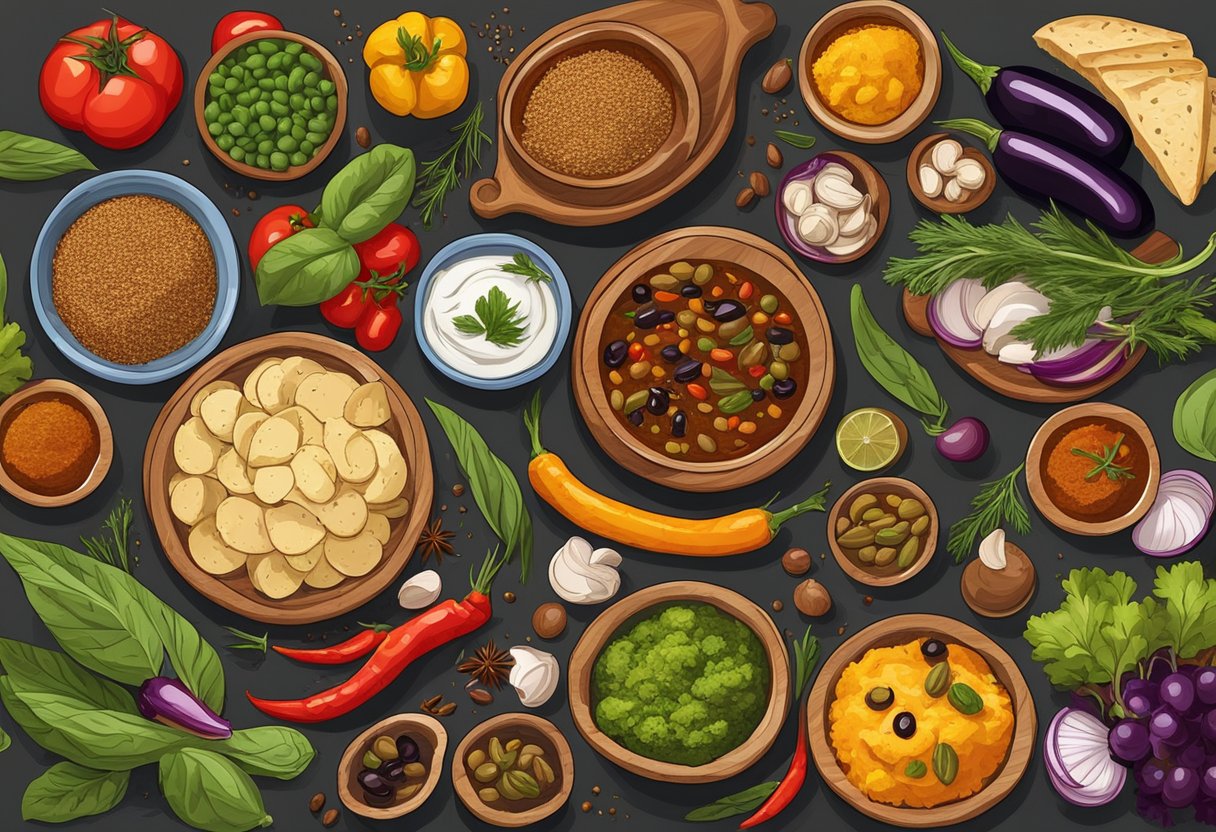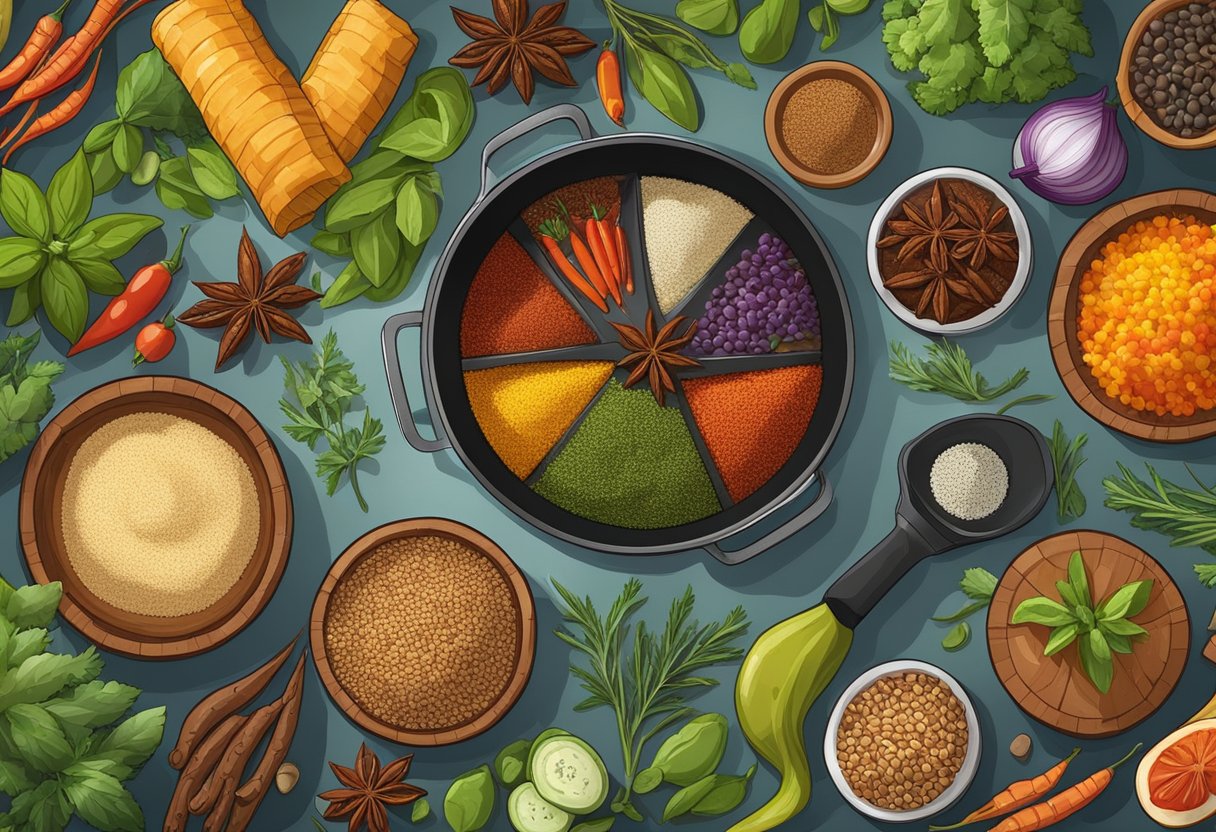The Mediterranean diet is praised for its flavorful array of foods that are not only delicious but also considered beneficial to health. Incorporating a gluten-free twist into this diet does not mean you will miss out on the rich flavors and spices that characterize Mediterranean cuisine. Those with gluten intolerance or celiac disease can confidently partake in this diet, utilizing a variety of gluten-free grains, proteins, and fats, all heavily seasoned with herbs and spices, bringing the essence of Mediterranean cooking to the forefront without compromising dietary restrictions.

Creating a balanced meal plan on a gluten-free Mediterranean diet involves mindful substitutions and a good understanding of core ingredients. Staples such as fresh vegetables, seafood, lean meats, nuts, seeds, and legumes take center stage, with herbs and spices such as basil, oregano, rosemary, and thyme adding depth and complexity to dishes. With a focus on whole, unprocessed foods, this diet encourages a holistic approach to eating that supports long-term health. The integration of flavorful herbs and spices not only enhances taste but also boosts nutritional value, making every meal an opportunity to nourish the body while delighting the palate.
Key Takeaways
- Adopting the gluten-free Mediterranean diet offers a fusion of health benefits and rich flavors.
- Key ingredients and spices are essential for authentic Mediterranean dishes without gluten.
- Planning and adapting meals within this dietary framework boosts confidence in maintaining a healthy, flavorful lifestyle.
Table of Contents
Basics of the Gluten-Free Mediterranean Diet

The Gluten-Free Mediterranean Diet harmoniously blends the heart-healthy principles of the Mediterranean lifestyle with the dietary needs of individuals who require gluten-free options. The diet emphasizes the consumption of a wide variety of vegetables, legumes, fruits, and healthy fats, particularly olive oil, which serves as the main source of added fat.
Without gluten-containing grains like wheat, rye, and barley, the focus shifts to gluten-free whole grains such as quinoa, rice, and corn. These grains are rich in fiber and essential nutrients, maintaining the diet’s wholesome nature.
| Gluten-Free Whole Grains | Alternative Healthy Fats |
|---|---|
| Quinoa | Nuts and seeds |
| Rice | Avocados |
| Corn | Fish oil and other Omega-3 oils |
| Buckwheat | |
| Oats (gluten-free) |
Fish and seafood are prominent proteins within this diet, consumed in moderation, and are excellent for their omega-3 fatty acids. Poultry is also included regularly but in lesser portions compared to the traditional Mediterranean diet.
The gluten-free Mediterranean diet reduces the intake of sweets and processes or red meat, maintaining a low profile for these items, and instead, encourages natural, simple flavors enhanced by spices and herbs.
Remember, careful attention to food labels and cross-contamination is crucial for those with gluten sensitivities or celiac disease when adapting to a gluten-free Mediterranean lifestyle.
Understanding Gluten Intolerance and Celiac Disease
Gluten intolerance encompasses a spectrum of disorders, including celiac disease, with gluten being the primary trigger for the associated symptoms and complications.
Role of Gluten in Celiac Disease
Celiac disease is a chronic condition where the immune system reacts abnormally to gluten, a protein found in wheat, barley, and rye. When individuals with celiac disease consume gluten, their immune response leads to inflammation and damage to the small intestine’s lining. This damage impairs nutrient absorption and can cause various symptoms ranging from digestive discomfort to malnutrition.
Gluten Sensitivities Beyond Celiac
Gluten sensitivities can manifest in individuals without celiac disease. These sensitivities cause symptoms similar to those of celiac disease, such as bloating and digestive issues, but without the intestinal damage. Gluten sensitivity is not as well-understood as celiac disease, but adhering to a gluten-free diet can alleviate the discomfort associated with this condition.
Core Ingredients and Substitutes

Adapting the flavors of the Mediterranean to a gluten-free diet requires selecting alternative grains and starches, understanding suitable protein sources, and choosing dairy wisely, particularly cheese.
Safe Grains and Starches
- Quinoa: A nutritious, gluten-free grain that can substitute for bulgur or couscous.
- Rice: Both white and brown rice are gluten-free and serve as the base for risottos or pilafs.
Protein Sources in a Gluten-Free Regimen
- Beans: Chickpeas, lentils, and other legumes are staple protein sources.
- Seeds and Nuts: Nutritious options for snacking or as a garnish.
- Eggs: Versatile for breakfast dishes or as a protein in salads.
Selecting Dairy and Cheese Varieties
- Dairy: Plain yogurts and unflavored milk are typically gluten-free.
- Olive Oil: Replaces butter for cooking and dressing.
- Feta: A traditional cheese that should be confirmed as gluten-free due to potential cross-contact.
- Cheese: Avoid varieties with additives that could contain gluten.
Designing a Balanced Meal Plan

Designing a meal plan on a gluten-free Mediterranean diet involves selecting foods that are both rich in flavor and nutritional value, while ensuring an absence of gluten-containing grains. Emphasis is on balancing proteins, fats, and carbohydrates at every meal to support sustained energy and overall health.
Planning Gluten-Free Breakfasts
For breakfast, they look to high-protein options such as Greek yogurt or scrambled eggs paired with gluten-free whole grains, like quinoa or millet. Ample fiber can be added with a side of mixed berries or an apple, which also provide a sweet burst of natural flavor to start the day. It’s essential for them to ensure that gluten-free breakfasts are not only nutritious but also varied to maintain interest and nutritional balance.
Sample Breakfast:
- Quinoa porridge with almonds and mixed berries
- Greek yogurt with gluten-free granola and honey
Creating Nutritious Lunches
Lunches on a gluten-free Mediterranean meal plan might feature grilled chicken or fish served over greens, with a variety of vegetables like bell peppers, cucumbers, and tomatoes. They dress salads with extra virgin olive oil and lemon for taste and healthful fats. Incorporating legumes such as chickpeas or lentils is also a great way to add both protein and fiber, keeping them full and energized throughout the afternoon.
Sample Lunch:
- Grilled salmon salad with mixed greens, cherry tomatoes, and olives
- Lemon-tahini dressing over a chickpea and vegetable medley
Enjoyable and Wholesome Dinners
Dinner can be a time of culinary exploration with boldly spiced stews or roasted meats. The individuals might incorporate spices like cumin, paprika, and turmeric into their dishes. Sides often include a portion of gluten-free grains or starchy vegetables, and heaps of roasted or steamed vegetables to provide a satisfying and nutritious end to the day.
Sample Dinner:
- Turmeric and cumin spiced chicken with roasted sweet potatoes
- Steamed broccoli with garlic and a drizzle of olive oil
Flavorful Herbs and Spices in Mediterranean Cuisine

Mediterranean cuisine is celebrated for its vibrant flavors, derived from an array of herbs and spices that are both delicious and consistent with a gluten-free diet. The use of these seasonings not only enhances taste but also offers numerous health benefits.
- Oregano: This robust herb is fundamental in Mediterranean dishes. Its earthy and slightly bitter taste pairs well with a variety of ingredients, making it a versatile choice for those following a gluten-free diet.
| Herb/Spice | Typical Uses | Flavor Profile |
|---|---|---|
| Parsley | Soups, salads, and garnishes | Fresh, slightly peppery |
| Cilantro | Sauces and grilled foods | Bright, lemony |
| Rosemary | Roasts and stews | Pine-like, aromatic |
-
Parsley: Rich in vitamins A, C, and K, parsley is often used as a garnish but can also play a central role in dishes like tabbouleh, enhancing them with its clean and peppery flavor.
-
Cilantro: Not as commonly used in traditional Mediterranean recipes, cilantro adds a refreshing and citrusy note, ideal for those looking for bold flavors without gluten.
-
Rosemary: Its needle-like leaves impart a woody aroma, and it can withstand longer cooking times, which makes it perfect for heartier gluten-free dishes that require depth of flavor.
Collectively, these herbs and spices form the backbone of the Mediterranean palette. They contribute to the diet’s reputation as savory and diverse while maintaining gluten-free integrity. Individuals can enjoy a wealth of flavors without the concern of gluten exposure, ensuring both safety and satisfaction in their culinary experiences.
Recipes and Cooking Techniques

This section provides a diverse collection of recipes and cooking methods tailored to the gluten-free Mediterranean diet that features vibrant spices and rich flavors. These culinary ideas are meant to inspire both novice cooks and experienced chefs to explore the delights of gluten-free Mediterranean cuisine.
Starter and Appetizer Recipes
For starters, one can craft a refreshing Quinoa Tabbouleh, where quinoa serves as a protein-rich, gluten-free alternative to bulgur wheat. Ingredients like fresh parsley, mint, tomatoes, and a zesty lemon dressing bring this dish to life. Additionally, making Falafel using chickpea flour instead of wheat-based flours can yield a satisfying and safely gluten-free appetizer.
Main Dishes and Entrees
Main courses shine with creativity, such as the seared Mediterranean Chicken marinated in herbs and spices. It can be accompanied by a Saffron-Infused Quinoa Pilaf, which not only complies with a gluten-free regimen but also emphasizes the traditional flavors of the Mediterranean region. A collection of gluten-free Mediterranean recipes offers a diverse range of dishes, spotlighting the diet’s adaptability and taste.
Sides and Salads
Side dishes are just as integral, where options like a Roasted Red Pepper Hummus blur the lines between sides and appetizers due to its versatile use. For a heartier side, a Mediterranean Roasted Vegetable Salad combines bell peppers, zucchini, and eggplant with a balsamic vinaigrette. These dishes can be easily found among Mediterranean diet recipes and are perfect for individuals seeking flavorful, gluten-free options.
Gluten-Free Snacks and Sweets
The joy of snacks and sweets on a gluten-free Mediterranean diet comes from both traditional and innovative creations, such as Almond Flour Biscotti or Fig and Walnut Energy Bites. These gluten-free snacks provide enjoyable treats without compromising dietary restrictions. Each bite is infused with the essence of the Mediterranean, offering a sweet finish or a quick, energizing snack.
Eating Out and Social Events

When adhering to a gluten-free Mediterranean diet, dining out and enjoying social events can come with its set of challenges. Individuals must be selective about restaurants and the meals they opt for to ensure their dietary needs are met. They should look for venues that offer naturally gluten-free items or those with a dedicated gluten-free menu.
- Vegetables and Fruits: Starters and sides rich in vegetables and fruits are staples of Mediterranean cuisine and naturally gluten-free.
- Seafood and Poultry: Grilled or baked seafood and poultry are excellent protein options, provided they haven’t been breaded or marinated in sauces containing gluten.
Legumes and Healthy Fats: Beans, lentils, and olive oil are central to the Mediterranean diet and should be consumed freely. These are not only gluten-free, but also packed with nutrients.
One should avoid dishes with breaded meats, croutons, or flour-thickened sauces. Instead, they might select:
- Grilled fish with a side of sautéed spinach.
- Salad with an olive oil-based dressing, minus croutons.
- Chicken skewers with a side of quinoa salad.
At social events, where the control over food preparation is limited, individuals should:
- Inform the host of their dietary restrictions ahead of time.
- Suggest gluten-free Mediterranean options that everyone can enjoy.
- Offer to bring a dish that fits their diet.
By communicating their needs and proactively participating in the planning, they ensure their dietary restrictions are accommodated without compromising the social aspect of dining. Remembering to hydrate mainly with water, enjoying moderate portions of wine, and focusing on fresh foods aligns with the principles of the Mediterranean diet.
Adapting Recipes for Health and Flavor

When one embraces a gluten-free Mediterranean diet, the focus is on maintaining the integrity of nutrition while amplifying flavor. This approach leans heavily on plant-based ingredients, which a nutritionist might recommend for their anti-inflammatory properties. Highly spiced, flavorful foods are well-suited to this diet, as they contribute both taste and health benefits.
For vegetarians and vegans, adapting recipes to a gluten-free Mediterranean diet can be as simple as substituting non-gluten grains such as quinoa or millet. These grains not only adhere to the dietary restrictions but also bring a variety of textures and flavors to the dish.
- Legumes: Chickpeas, lentils, and beans can be spiced with cumin, coriander, or turmeric to create hearty, satisfying meals.
- Vegetables: Eggplants, tomatoes, and bell peppers, seasoned with herbs like oregano and thyme, offer a robust palette of flavors and are fundamental in Mediterranean cooking.
- Nuts and Seeds: Almonds, walnuts, and flaxseeds provide crunch and are ideal for adding depth to dishes.
A nutritionist might also advise incorporating fatty fish like salmon or mackerel into one’s diet, which can be prepared with a variety of spices and herbs to elevate flavor while contributing to health. They suggest using extra virgin olive oil as a heart-healthy fat for dressings, marinades, and cooking, enhancing both taste and nutritional value.
For those seeking advice on adapting to this lifestyle, they need to look no further than recipes such as Mediterranean Chicken with Orzo Salad or Lemon-Herb Salmon with Caponata & Farro, which exemplify a perfect blend of flavor and healthful eating. It’s about making informed choices to create meals that satisfy both the palate and nutritional needs.
Shopping and Creating Your Grocery List

Crafting a grocery list for a gluten-free Mediterranean diet involves a keen eye for both gluten-free products and the fresh ingredients that epitomize Mediterranean cuisine.
Identifying Gluten-Free Products
It’s crucial for those with gluten sensitivities to seek out clearly labeled gluten-free options when shopping. Gluten can often be hidden in processed foods, so reading labels is imperative. One should look for certification marks from reputable gluten-free organizations, which offer greater assurance that products meet strict gluten-free standards.
Key Gluten-Free Staples:
- Pasta: Look for varieties made from rice, quinoa, or legumes.
- Breads: Choose those made with gluten-free flours such as almond or coconut flour.
- Cereals: Opt for gluten-free grains like millet, buckwheat, and gluten-free oats.
Tips for Verification:
- Check the ingredients list for hidden sources of gluten such as malt flavoring or modified food starch.
- Use apps or gluten-free guides to help identify safe products.
Stocking Up on Mediterranean Essentials
A well-stocked pantry is the cornerstone of the Mediterranean diet, focusing on plant-based ingredients and wholesome fats while limiting red meat. Freshness and quality are pivotal—produce should be seasonal and seafood should be sourced with sustainability in mind.
Vegetables and Fruits:
- Aim for a rainbow of colors: dark leafy greens, vibrant bell peppers, deep red tomatoes, and purple eggplants.
- Incorporate fruits into meals and snacks, such as figs, grapes, and citrus fruits, for their antioxidants and fiber.
Healthy Fats:
- Extra virgin olive oil is a staple for cooking and dressings, revered for its heart-healthy monounsaturated fats.
- Nuts and seeds (always ensuring they’re gluten-free) are nutritious snack options.
Protein Sources:
- Seafood should feature prominently on one’s list, with an emphasis on fatty fish like salmon and mackerel for their omega-3 fatty acids.
- For those who eat animal products, poultry is a better choice than red meat and should be consumed in moderation.
Incorporating these Mediterranean essentials in a gluten-free diet enhances not only flavor but also nutritional value, aligning with the healthful principles of the diet that spans the Mediterranean Sea.
Considering Mediterranean Diet for Long-Term Health

The Mediterranean diet, when adapted for a gluten-free lifestyle, holds promise for improving long-term health through its preventive benefits against chronic diseases.
Preventive Benefits Against Chronic Diseases
Research suggests that a gluten-free Mediterranean diet offers various health benefits that may play a role in staving off chronic conditions. The diet enlists an array of fruits, vegetables, nuts, and legumes, all naturally gluten-free and rich in essential nutrients, to contribute to overall well-being.
Impact on Heart Disease and Cancer
Specifically, the dietary pattern emphasizes heart-healthy fats from sources like olive oil which has been associated with a lower risk of heart disease. Moreover, the inclusion of lean proteins, such as fish, supplies omega-3 fatty acids that support cardiovascular health. The high fiber content from whole grains—albeit gluten-free alternatives such as quinoa and brown rice—along with antioxidant-rich spices and herbs, may also contribute to reduced cancer risks.
Resources and Support for Gluten-Free Mediterranean Lifestyle

Individuals seeking guidance on adopting a gluten-free Mediterranean diet have a wealth of resources at their disposal. One of the primary organizations offering support is the Celiac Disease Foundation. Their unbiased resources can be invaluable for those managing celiac disease, providing carefully curated meal plans and comprehensive educational materials that address both diet and lifestyle needs.
Social media platforms such as Pinterest serve as another innovative repository for gluten-free Mediterranean recipes and meal inspirations. Users can discover a myriad of flavorful, spiced options curated by others who share a passion for maintaining a healthy, balanced diet without the inclusion of gluten.
Important Considerations
- Medical Advice: It is crucial to consult with a healthcare provider before making significant dietary changes. They offer personalized diagnosis and advice tailored to one’s individual health needs.
- Support Groups: Joining gluten-free support groups can be incredibly beneficial. They provide a sense of community and shared experience that can be comforting and informative for those new to the lifestyle.
Below is a quick reference guide for those seeking information and support:
| Resource Type | Description |
|---|---|
| Educational Materials | Offered by organizations like the Celiac Disease Foundation, covering diet specifics and gluten-free living. |
| Recipe Inspiration | Found on platforms such as Pinterest, featuring a variety of gluten-free Mediterranean dishes. |
| Healthcare Providers | Essential for obtaining a diagnosis and managing celiac disease through informed medical advice. |
| Community Support | Groups and forums where individuals can share experiences and advice on living with a gluten-free Mediterranean diet. |
These resources equip individuals with the knowledge and support needed to confidently navigate a gluten-free Mediterranean diet.
Frequently Asked Questions

In addressing frequently asked questions, individuals will gain clarity regarding the adaptation of traditional Mediterranean flavors to a gluten-free lifestyle.
What gluten-free grains are most suitable for a Mediterranean diet?
Gluten-free grains that complement the Mediterranean diet include quinoa, millet, and brown rice. These grains are versatile and can be incorporated into a variety of dishes, offering both flavor and nutrition.
How can one make Mediterranean dishes without gluten or dairy products?
One can substitute the gluten with naturally gluten-free grains and use alternatives to dairy such as almond milk or coconut yogurt. Ingredients like olive oil, garlic, and a range of spices contribute to the rich flavors characteristic of Mediterranean cuisine.
What are the recommended gluten-free Mediterranean snacks?
Recommended snacks include fresh fruit, nuts, seeds, and vegetables paired with hummus or baba ghanoush. Snacks like these are not only nutritious but also align with the principles of a gluten-free Mediterranean diet.
Which are the primary ingredients in an anti-inflammatory gluten-free Mediterranean diet?
Primary ingredients include leafy greens, fatty fish like salmon, nuts, seeds, and a variety of spices such as turmeric and ginger. These ingredients are known for their anti-inflammatory properties and are foundational to the diet.
Can you recommend any authoritative cookbooks for gluten-free Mediterranean recipes?
Yes, cookbooks by trusted nutritionists and chefs who specialize in gluten-free cooking are a valuable resource. These authors often provide both recipes and guidance for maintaining a gluten-free Mediterranean diet.
What foods are typical on a Mediterranean diet but are restricted for those following a gluten-free lifestyle?
Typical foods that are restricted include wheat-based pasta and bread. They are common in Mediterranean diets but must be avoided or substituted with gluten-free alternatives by those with celiac disease or gluten sensitivity.



